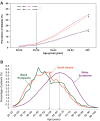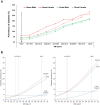Lessons Learned From Epidemiology of Type 2 Diabetes in South Asians: Kelly West Award Lecture 2024
- PMID: 39841965
- PMCID: PMC11770170
- DOI: 10.2337/dci24-0046
Lessons Learned From Epidemiology of Type 2 Diabetes in South Asians: Kelly West Award Lecture 2024
Abstract
South Asia has high prevalence rates of type 2 diabetes (T2D). Until the 1990s, the prevalence of T2D within South Asia was low but much higher in the South Asian diaspora living abroad. Today, high prevalence rates of T2D are reported among those living in South Asia. T2D in South Asians presents with unique clinical features described as the "South Asian phenotype" that include younger age at onset of diabetes than in White Europeans, much lower BMI, hyperinsulinemia and greater insulin resistance, rapid decline in β-cell function resulting in low insulin reserve, low muscle mass, and greater ectopic fat deposition, especially in the liver. Also, prevalence of impaired fasting glucose is higher among South Asians than prevalence of impaired glucose tolerance. Genetic predisposition combined with intrauterine fetal programming (low vitamin B12 intake and high folate intake) increases susceptibility to T2D, from birth. In later life, overnutrition, especially a high carbohydrate intake with refined grains of higher glycemic index, coupled with low physical activity likely triggers the T2D epidemic in South Asians. Additionally, there are emerging risk factors like air pollution. Preventing T2D in South Asians requires a multifactorial approach, including improvements in maternal and fetal nutrition with special reference to vitamin B12 and folate intake, decreasing refined carbohydrate and increasing protein and fiber intake in the diet, increasing physical activity, and control of air pollution. Lessons learned from epidemiology of T2D in South Asians could be useful to other developing countries that are in earlier stages of epidemiological transition.
© 2025 by the American Diabetes Association.
Conflict of interest statement
Figures







Similar articles
-
Adipose tissue-derived metabolite risk scores and risk for type 2 diabetes in South Asians.Int J Obes (Lond). 2024 May;48(5):668-673. doi: 10.1038/s41366-023-01457-4. Epub 2024 Jan 20. Int J Obes (Lond). 2024. PMID: 38245659 Free PMC article.
-
Genetic basis of early onset and progression of type 2 diabetes in South Asians.Nat Med. 2025 Jan;31(1):323-331. doi: 10.1038/s41591-024-03317-8. Epub 2024 Nov 26. Nat Med. 2025. PMID: 39592779 Free PMC article.
-
Obesity and dyslipidemia in South Asians.Nutrients. 2013 Jul 16;5(7):2708-33. doi: 10.3390/nu5072708. Nutrients. 2013. PMID: 23863826 Free PMC article. Review.
-
The metabolic syndrome in South Asians: epidemiology, determinants, and prevention.Metab Syndr Relat Disord. 2009 Dec;7(6):497-514. doi: 10.1089/met.2009.0024. Metab Syndr Relat Disord. 2009. PMID: 19900153 Review.
-
Prevalence, risk factors and complications associated with type 2 diabetes in migrant South Asians.Diabetes Metab Res Rev. 2012 Jan;28(1):6-24. doi: 10.1002/dmrr.1219. Diabetes Metab Res Rev. 2012. PMID: 21591242 Review.
Cited by
-
Prevalence of diabetes distress among people with type 2 diabetes in South Asia: A systematic review and meta-analysis.World J Diabetes. 2025 Aug 15;16(8):109352. doi: 10.4239/wjd.v16.i8.109352. World J Diabetes. 2025. PMID: 40837336 Free PMC article.
References
-
- International Diabetes Federation . IDF Diabetes Atlas, 10th edition, 2021. Accessed 15 July 2024. Available from https://diabetesatlas.org/atlas/tenth-edition/
-
- UN-Library. India Overtakes China as the World’s Most Populous Country . Accessed 15 July 2024. Available from https://www.un-ilibrary.org/content/papers/10.18356/27081990-153#:∼:text... - DOI
-
- Gupta OP, Joshi MH, Dave SK. Prevalence of diabetes in India. Adv Metab Dis 1978;9:147–165 - PubMed
-
- Zimmet P, Taylor R, Ram P, et al. . Prevalence of diabetes and impaired glucose tolerance in the biracial (Melanesian and Indian) population of Fiji: a rural-urban comparison. Am J Epidemiol 1983;118:673–688 - PubMed
-
- Dowse GK, Gareeboo H, Zimmet PZ, et al. .; Mauritius Noncommunicable Disease Study Group . High prevalence of NIDDM and impaired glucose tolerance in Indian, Creole, and Chinese Mauritians. Diabetes 1990;39:390–396 - PubMed
Publication types
MeSH terms
Grants and funding
LinkOut - more resources
Full Text Sources
Medical

